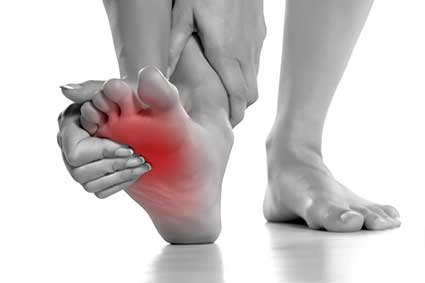Diabetic neuropathy symptoms often include:
- Burning pain sensation

Common Symptoms for Three Types of Diabetes Related Peripheral Neuropathies – Diabetic neuropathy symptoms - Sharp Stabbing pains
- Pins and Needles
- Hypersensitivity sensitivity to light touch
- Numbness
- Tingling
- Difficulties distinguishing hot and cold temperature changes
- Muscle weakness
- Decrease in muscle size (atrophy)
- Contrictions
- Tightness
- Cramps
- Walking and Standing difficulties balance and coordination problems
- Foot infections, wounds, ulcers
Common symptoms of autonomic diabetic neuropathy may include:
- Swelling or bloated feeling
- position change dizziness ex: standing up
- Increased heart rate
- Decreased appetite
- Digestive problems vomiting hours after eating low blood sugar unawareness
- Indigestion/heartburn
- Bowel or bladder control difficulties
- Decreased or increased perspiration sexual dysfunction
Common symptoms of proximal diabetic neuropathy:
- Pelvic and upper leg pain(hip/thigh/buttock)usually on one side.
- Decrease muscle size and strength in the legs.
- Pain in the abdominal region.
- Muscle atrophy and weakness in the legs.
- Difficulty changing positions from sitting or lying down to standing up.
Common Symptoms Mononeuropathy diabetic neuropathy may include:
- Weakness and numbness in fingers, hand and/or wrist referred to as carpal tunnel syndrome.
- Vision problems and/or eye pain typically only on one side.
- Vision problems.
- Partial face paralysis on side as found with Bell’s Palsy.
Neuropathy pain tends to be worse at night. This makes it difficult to get a full night’s sleep which can lead to other health problems and increase in pain and other symptoms.
Why Ischemia Is A Major Factor In the Development of Peripheral Neuropathy?
Health nerves receive oxygenated blood and nutrition through microscopic capillaries. Damage and/or obstruction to these small blood vessels as a result of high blood sugar, toxins, mechanical entrapment restricts the transfer of oxygen and nutrition to the nerve cells causing nerve cell death.
Diabetic patients are at a very high risk because these small capillaries of people with diabetes can become obstructed when a large amount of glucose fills the bloodstream. This glucose obstruction prevents the nerve tissues from receiving the nutrients and oxygen needed for health functioning nerves.
Peripheral neuropathy is a serious diabetes complication and is estimated to affect up to 70% of people with diabetes. The feet are the most common area of the body where the nerves are damaged as a result of high blood sugar resulting in the need for peripheral neuropathy treatment.
Is there an effective treatment for Diabetic Neuropathy?

Dr. Alfonso‘s Neuropathy Treatment Protocol utilizes 8 specialized treatments designed to improve the supply of oxygen, eliminate waste, and improve nutrition to damaged nerves. Increased circulation to the damaged peripheral nerves combined with treatments to stimulate peripheral nerve cell regeneration, and repair.
Dr. Alfonso Neuropathy Treatment Protocol
Improves and increases oxygen and nutrition through the increase of circulation to the damaged nerves.
Repairs peripheral fibers by stimulating regenerative of new nerve cells.
Removes and eliminates mechanical peripheral nerve entrapments and compressions in the spine and extremities
For more info on the Dr. Alfonso Neuropathy Treatment Protocol please visit our treatment page of our website.
www.neuropathyreliefmiami.com/en/treatment/
Dr. Rodolfo Alfonso, D.C.
Neuropathy Relief Center Of Miami
8585 Sunset Dr. STE 104
Miami, Florida 33143
305-275-7475
www.neuropathyreliefmiami.com
[vc_row css_animation=”” row_type=”row” use_row_as_full_screen_section=”no” type=”full_width” angled_section=”no” text_align=”left” background_image_as_pattern=”without_pattern”][vc_column][button size=”big_large_full_width” icon=”fa-medkit” target=”_self” hover_type=”default” text_align=”center” text=”Dr. Alfonso‘s Neuropathy Treatment Protocol” link=”https://neuropathyreliefmiami.com/treatment/” color=”#ffffff” background_color=”#0090ff” icon_color=”#ffffff”][/vc_column][/vc_row][vc_column][/vc_column]

